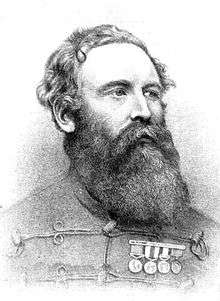Harry Burnett Lumsden
| Sir Harry Burnett Lumsden | |
|---|---|
 Sir Harry Burnett Lumsden | |
| Born | 12 November 1821 |
| Died | 12 August 1896 |
| Allegiance |
|
| Service/branch |
|
| Rank | Lieutenant-General |
| Battles/wars |
First Anglo-Sikh War Second Anglo-Sikh War Indian Rebellion |
| Awards |
Knight Commander of the Order of the Star of India Companion of the Order of the Bath |
Lieutenant-General Sir Harry Burnett "Joe" Lumsden KCSI, CB (12 November 1821 – 12 August 1896) was a British military officer active in India.
Life
Lumsden was born aboard the East India Company’s ship Rose in the Bay of Bengal, the son of a British Army Colonel Thomas Lumsden, C.B. He was shipped to Scotland to study at age 6, and returned to India at age 16.
Lumsden joined the 59th Bengal Native Infantry in 1838, was present at the forcing of the Khyber Pass in 1842. He fought in the First and Second Sikh Wars, being wounded at Sobraon.
He became assistant to Sir Henry Lawrence at Lahore in 1846, and in 1847 was appointed to raise the Corps of Guides. On 6 February 1847 Lumsden wrote to his father: "..I have just been nominated to raise the corps of Guides. It will be the finest appointment in the country..". [1] A few months later he was joined by his Second-in-Command, William Stephen Raikes Hodson, who wrote to his brother (George Hodson) on 16 September 1847 "..of my good fortune... I am to be the Second-in-Command with the Corps of Guides". [2]
The object of the new Corps, composed of horse cavalry and foot soldiers, was to provide trustworthy men to act as guides to troops in the field, and also to collect intelligence beyond as well as within the North-West frontier of India. The regiment was located at Mardan on the Peshawar border, and became one of the most famous in the Indian army. For the equipment of this corps, Lumsden originated the khaki uniform in 1848. "..in connection with clothing and arming the new Guide Corps, Lumsden had left such matters almost entirely in his subaltern Hodson's hands. The two men agreed in the choice of Khaki or dust colour for the uniform of the Guides.." [3]
In 1857 he was sent on a mission to Kandahar with his younger brother, Sir Peter Lumsden, and Henry Walter Bellew in connection with the subsidy paid by the Indian government to the amir, and was in Afghanistan throughout the Indian Rebellion. He took part in the Waziri Expedition of 1860, was in command of the Hyderabad Contingent from 1862, and left India in 1869.
He was promoted to lieutenant-general in 1875; that same year he retired and moved to Scotland where he spent the rest of his days.
Notes
References
- "Lumsden of the Guides" (London, 1899) by Peter Lumsden and George Robert Elsmie.
- "Twelve Years of a Soldier's Life in India; being extracts from the letters of the late Major W.S.R. Hodson, Hodson of Hodson's Horse" (London, 1859), edited by George H. Hodson.
- Lionel James Trotter A Leader of Light Horse: Life of Hodson of Hodson's Horse (W. Blackwood and sons 1901, 1910)
External links
- Story of the Guides, by G. J. Younghusband, 1908, from Project Gutenberg. Lumsden founded ('raised') the Queen's Own Corps of Guides.
- Corps of Guides, article discussing the raising of the Guides by Lumsden.